News & Insights
Beyond the Basics: 4 Material Considerations You May Not Know
November 18, 2021
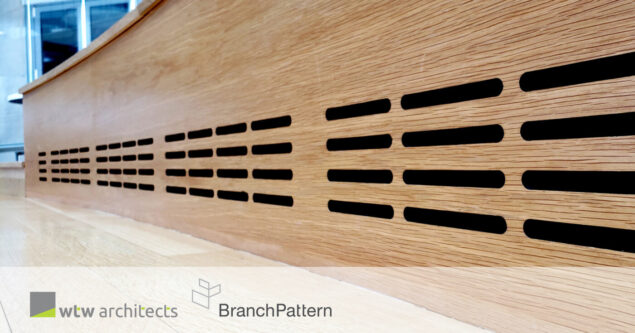
When selecting building materials, considerations of schedule, cost, aesthetics, and code requirements usually take center stage. While these are important factors to weigh, other elements can be evaluated between the first design meeting and the first day of construction.
Materials have both an internal (use, occupant health, etc.) and external impact (emissions, waste, etc.), and we have outlined 4 areas of consideration to better address a material’s full impact extent.
The material selection process must find balance for the benefit of people and the planet. We will explore material consideration to help you address the full impact of each, in the following categories:
- Maintenance
- Indoor Environmental Quality
- Embodied Carbon
- Biophilic Material Selection
1) INDOOR ENVIRONMENTAL QUALITY
Indoor Environmental Quality (also known as IEQ), refers to the quality of a building’s environment in relation to the health and well-being of its occupants[1]. IEQ covers indoor air quality (IAQ), thermal comfort, acoustics, and lighting quality.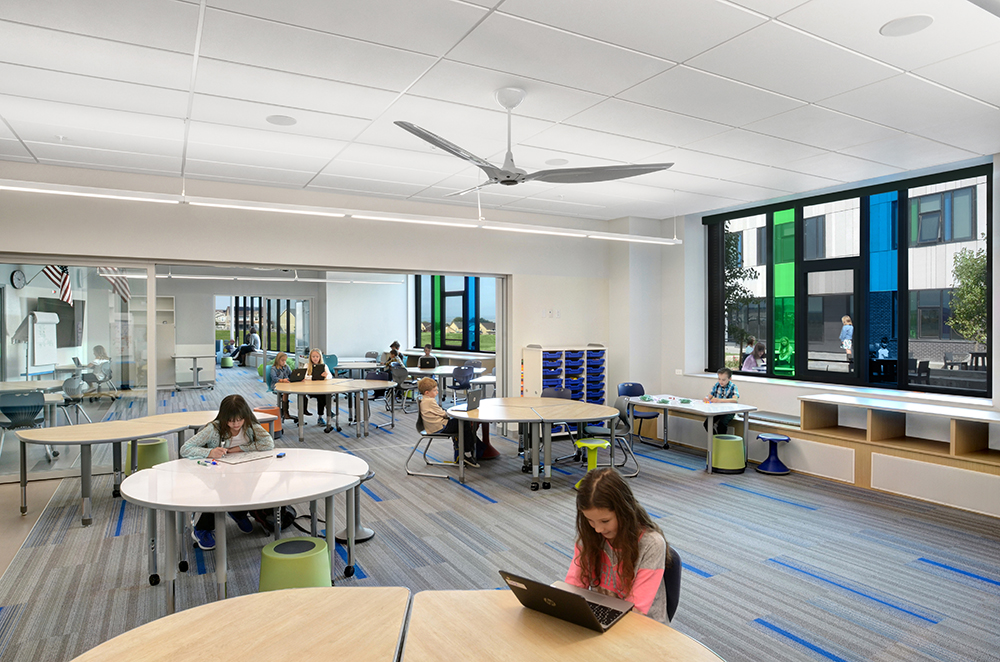
Meadowlark PK-8 School, Erie, CO | A low energy in-floor radiant heating and cooling system works in tandem with a floor supplied displacement ventilation system to provide flexible conditioning of the occupied zone. Image provided by BranchPattern.
IAQ has gained recent traction during the COVID-19 pandemic, due to the widespread understanding of the impact the built environment can have on occupant health. Ideally, the emphasis on IAQ will lead to a greater focus on IEQ overall. In addition to a person’s physical health, IEQ can impact the mental well-being of tenants. A building with a strong IEQ results in spaces that promote occupant productivity and satisfaction, which in turn can have long-term cost benefits for a company.
To improve IAQ, in particular through material selection, choose ones with low toxins and low emissions. As a building owner, your project doesn’t need to seek a Green Building Certification to set material standards. However, it’s often helpful to use credits as a reference when developing your own standards. For owners and AEC Teams, understanding International Living Future InstituteSM (ILFI)’s Declare label and USGBC’s LEED® credit Low-Emitting Materials can be a great place to start. For manufacturers, ILFI’s Living Product Challenge Health & Happiness Petal addresses levels of toxins in materials and their production.
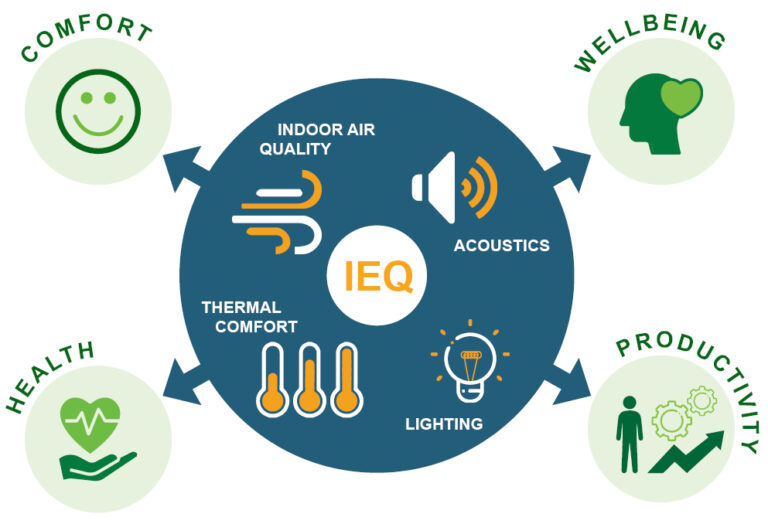
Based on your project’s program, a material’s ability to reduce bacteria or viral growth and spread may also be important. However, using anti-microbial treatments isn’t always advisable since we still don’t fully understand the complexity of the built environment’s microbiome. Owners can mandate the use of cleaning products without harsh chemicals or toxins, which pollute the indoor air (re: the WELL Building Standard Cleaning protocol). Additionally, the amount of dirt that can be trapped within a material assembly can be a factor in certain settings.
It’s important to include quantified estimates on occupant health and productivity to help drive decision-making. If you’re interested in learning how to do this on your project, reach out to BranchPattern for more information.
When choosing materials for workplace, learning and social settings, occupant comfort is often a priority.
2) EMBODIED CARBON
Embodied Carbon encompasses the greenhouse gas emissions from manufacturing, transportation, installation, maintenance, and disposal of building materials[2].Globally, embodied carbon of buildings accounts for 11% of all greenhouse gas emissions[3]. However, the AEC industry has a large influence on the manufacturing of many materials beyond those directly attributed.
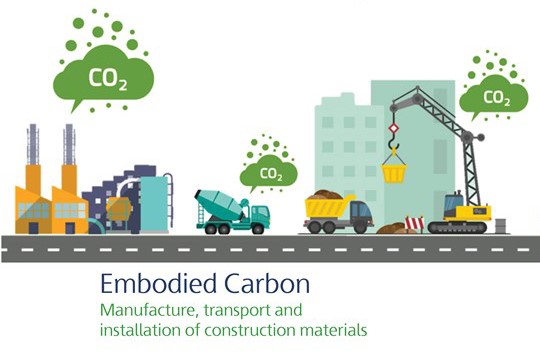
Source: Skanska.com
Understand resources available to select lower embodied carbon materials.
- Carbon Smart Materials Palette is a helpful resource when comparing materials such as concrete, wood, insulation, and more.
- The Carbon Leadership Forum has numerous resources from Policy Toolkits to Carbon Storing Materials to Case Studies.
- Building Transparency (owns EC3 tool and Tally software) also offers resources on specification language and EPD requests.

Procuring products with an established EPD (environmental product declaration) can help paint the embodied carbon picture on your project. EPDs factor common impact categories, one of which measures the product’s carbon footprint – Global Warming Potential (GWP). However, the best way to see the full embodied carbon picture is to perform a Life Cycle Assessment (LCA). An LCA is a method to track environmental impacts over the full life-cycle of products or processes. Whole Building LCAs can help answer the question “What is the impact of my building, composed of many different materials?”
Addressing embodied carbon exists in a few Green Building Certification programs, such as ILFI’s Living Building Challenge Materials Petal and USGBC’s LEED credits Building life-cycle impact reduction and BPDO – Environmental Product Declarations. As a part of achieving these credits, project teams are required to evaluate their project against a baseline and consciously make a reduction in embodied carbon. Project owners and teams can certainly use these credits as a guiding framework, but reductions can be made independently especially by targeting high-impact materials such as structure and facade elements.
3) BIOPHILIC MATERIAL SELECTION
Biophilic design encompasses design practices that seek to reconnect humans with nature. Research has shown that biophilic design reduces stress, expedites healing, and improves cognitive function, creativity, and the overall well-being of building occupants.Environmental leaders from Terrapin Bright Green, LLC have broken the theory of biophilia down into 3 categories, and a total of 14 characteristics. This white paper now serves as the framework of biophilic design in the built environment. For this article, we will only focus on the characteristics that apply to material selection and installation.
CATEGORY 1: Nature IN the Space
It is psychologically and physiologically fundamental for humans to feel part of nature on a regular basis, even though we spend most of our waking hours indoors.
- Thermal & Airflow Variability – Incorporating subtle changes in air and surface temperature across the skin that mimic natural environments. Incorporating materials with different textures in furniture, casework, and wall materials can give users opportunities to excite their tactile senses.
- Presence of Water – Provide access for occupants to see, hear, and/or touch water. The means and method of installation, and the material used to contain it, will affect whether the water is an audio landmark and how easy it is for users to touch.
- Dynamic & Diffuse Light – Use of light and shadow to mimic conditions found in nature, and designing light levels to differentiate spaces. In addition to the light fixtures themselves, the materials on the walls and floors will affect how much light bounces around the space or absorbs into the finishes, further differentiating the spaces.
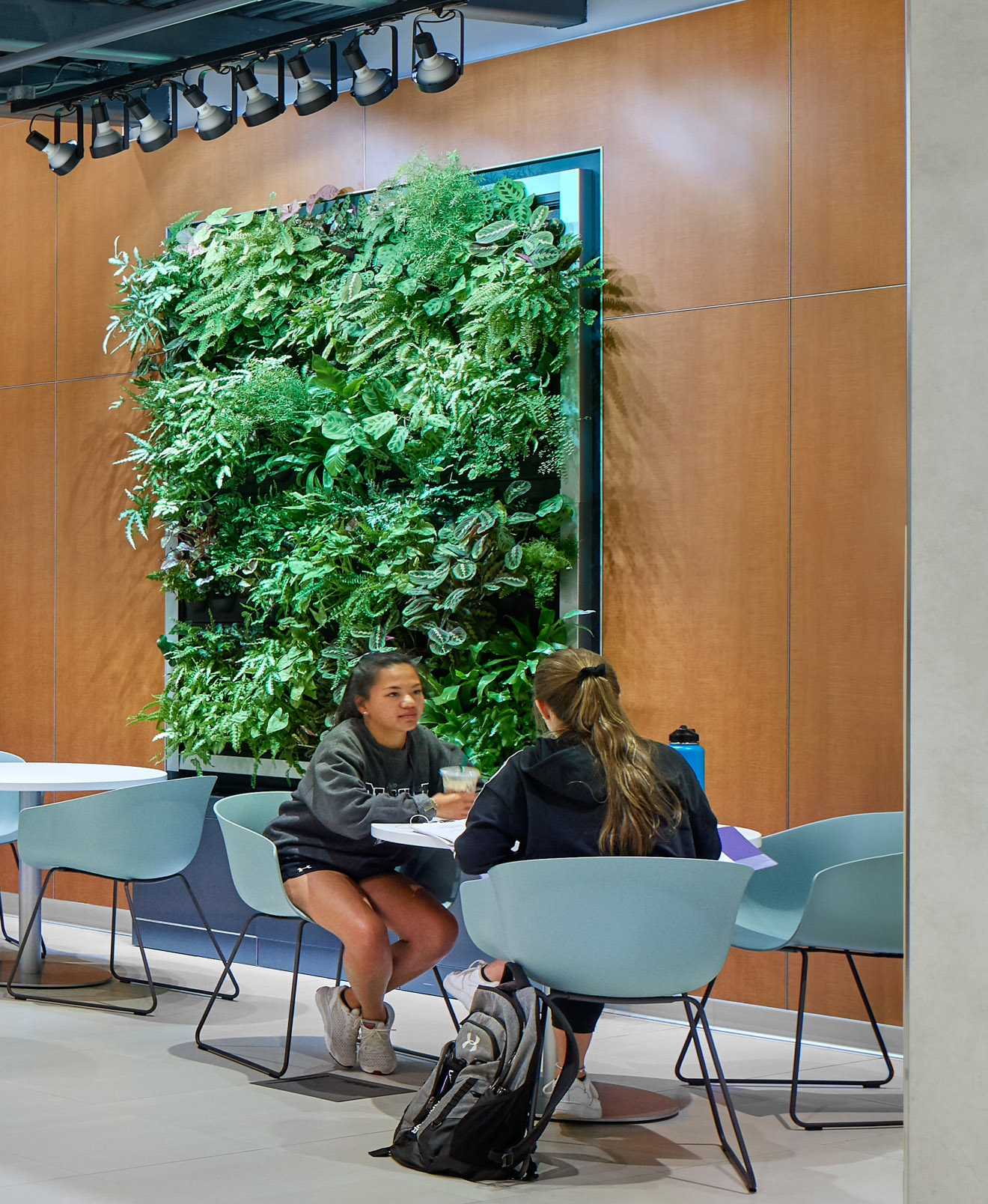
Pattee Library, Penn State, State College, PA | Living walls have been installed in many study and collaboration spaces in recent library renovations, and these areas are among the most popular with students. Due to the library size, not all study spaces have access to natural light and views, and these plant installations help bring the outdoors in.
CATEGORY 2: Natural Analogies and Providing Indirect Evocations of Nature Expressed as Artwork, Furniture, Décor and Textiles
Objects, materials, colors, shapes, and patterns found in nature can be incorporated into the interior design of a space.
- Biomorphic forms and Patterns – This refers to symbolic representations within the design of patterns, shapes, or textures found in nature. Think leaf and flower patterns, wood grain, and textured resin panels.
- Material Connection to Nature – This effect is accomplished by using materials, grains, textures, and elements in design that clearly reflect the natural environment. Use of wood, stone, or man made materials that mimic natural materials is the primary way to achieve this characteristic.

Translucent panels are used to break up a large study space into areas with different furniture types, while still allowing natural light to filter through the space. In this installation, images of dandelions and leaves were incorporated into the panels to add biophilic imagery to the architectural element.
CATEGORY 3: Nature OF the Space
These patterns are about our relationship to the building, room, or space as humans. These characteristics can be enhanced through material choice, but are primarily about the design and arrangement of elements.

Stanley Aviation Marketplace, Denver, CO. Image provided by BranchPattern.
4) MAINTENANCE
Every homeowner understands maintenance on a small scale – whether it is having a great vacuum to keep carpets clean or repainting exterior trim – each material chosen for the inside or outside of a house has short-term cleaning requirements and long-term needs for upkeep, refurbishment, or replacement. The same is true for commercial buildings, but at a larger scale and with a hired staff.Maintaining commercial buildings requires more cleaning product, more operating hours for equipment, and more people needed to do the work. It means more water & energy use, and more impact on custodial and operations employees. Therefore each decision to select a material has a more significant impact. 150,000 sf of flooring that needs to be cleaned twice a day is going to use a lot more resources than flooring that only needs to be cleaned once a day. This a consideration of resources, operational efficiency, and the long-term costs of operating the building.

East Union, University of Nebraska-Lincoln, Lincoln, NE | A combination of different materials will often make sense to respond to traffic patterns and ease of cleaning. Non-porous flooring materials like ceramic tile are easy to wipe down in high traffic areas and carpet works well in lower traffic seating areas which require regular vacuuming for dirt and dust. Wire mesh panels is a good choice for translucent guards that don’t require the same frequency of cleaning as glass guard panels.
There are no perfect materials. Maybe the best finish for a unique space needs more frequent cleaning but is expected to last longer than other options. Or maybe it has a quality of acoustic absorption that is a reasonable trade-off for a shorter replacement cycle. The important step is to have conversations about each finish related to how and when it will require cleaning, and how long it is expected to function before it requires refurbishment and/or replacement. Including maintenance and facilities personnel in these conversations is critical to successful operation as well as gaining buy-in. The Healthy Building Network brings research, data, and general education to the forefront in order to eliminate toxic chemical use in our world. Understanding the nature of the selected finishes leads to a better understanding of your building and how to keep it operating efficiently.
WHERE TO START?
With so many factors to consider, beginning may be the most difficult step. It’s important to evaluate what area will make the most impact on your project. Below, we’ve created a comparison of a few common indoor and outdoor materials. We’d like to point out that these comparisons are generalizations and do not consider any specific brand or any specific geographic location.

LVT vs Terrazzo
Luxury Vinyl Tile (LVT) and Thin-Set Terrazzo (a poured or pre-cast composite flooring system)
IEQ: When considering IEQ, Luxury Vinyl Tile (LVT) and Terrazzo can each meet low-toxin and zero-emissions standards. Both materials are hard surfaces, so other acoustic control practices should be employed when using these materials. Additionally, the aesthetics of the material choice can lead to a higher IEQ, such as color, pattern, and reflectivity.

Howard Gittis Student Center, Temple University, Philadelphia, PA | LVT was used throughout the dining area and atrium of this renovation to make daily cleaning easier for a lower initial cost than porcelain tile.
EMBODIED CARBON: While not all products are created equal, LVT flooring generally has a slightly higher embodied carbon footprint when considering the cradle-to-grave cycle. (Cradle-to-grave covers product, construction, use, and end-of-life stages). Terrazzo’s durability gives the product an advantage when looking at a typical building lifespan (60 years). However, when looking at upfront embodied carbon alone (product stage – also known as Module A), LVT has the advantage. Considering longevity and replacement of materials is critical when evaluating embodied carbon impact.
BIOPHILIA: From a Biophilic lens, flooring options can enhance the user experience by providing the visual appearance of natural materials or by incorporating biomorphic patterns. Plank tiles that look like wood or other natural materials will enhance the use experience, and there is a similar benefit to terrazzo patterns that incorporate larger aggregate or stone that simulates a creek bed or stone outcropping.
MAINTENANCE: When it comes to maintenance, LVT and Terrazzo are similar. Both require daily dry sweeping to prevent the accumulation of dirt and debris that can affect the wear layer. Both can be cleaned 1-2 times a week with a two-bucket system using a neutral cleaner and clean water. And both have products that can be added periodically to add sheen and protect the wear layer. For long-term care, the LVT is less intense, requiring only a mop applied finish which does not require buffing. In the case of Terrazzo, the floor will need to be attended to twice a year, stripping the existing water-based sealer, reapplying a new coat, and buffing the surface before it dries. But despite the easier long-term care, a building owner can anticipate that LVT will require replacement after 20-30 years, whereas a Terrazzo floor can last the lifetime of the building.

Findlay Commons, Penn State, State College, PA | Terrazzo installed when the building was constructed 50+ years earlier was stripped and polished to a like new appearance when this dining hall was renovated in 2016.
Aluminum composite material (ACM) Panel vs. Brick Rainscreen
IEQ: Moisture and thermal comfort issues can arise in both ACM Panel and brick rainscreen facades. Therefore, there is no major difference in IEQ when comparing these materials. Additionally, building massing and elevations can be manipulated to support better interior lighting, so neither cladding material makes a significant difference.
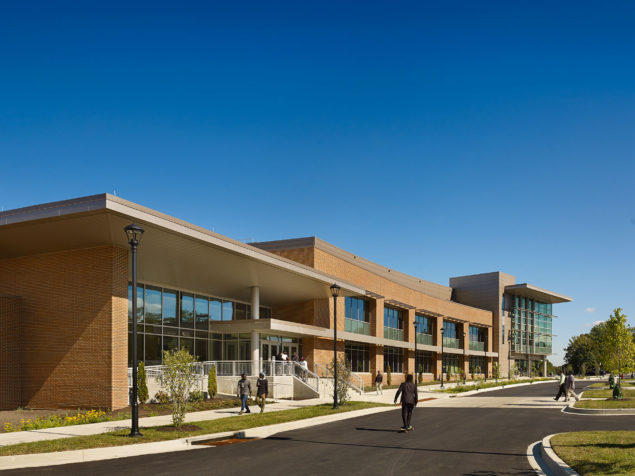
Student Union, Bowie State University, Bowie, MD | The new Student Union at Bowie State uses both ACM panels and masonry in the façade, which frequently happens in larger buildings to break up architectural elements and massing. In this design, brick is focused on installations at grade and ACM is used at vertical planes and upper walls away from the public.
EMBODIED CARBON: When comparing these exterior cladding materials, ACM Panel generally has a higher embodied carbon footprint. While the construction stage of brick is more intensive, the product stage of ACM along with the use stage is even more intensive. Brick stands the test of time, making it a strong choice for lower embodied carbon impact. Note that this comparison is of the cladding materials themselves, not of full wall assemblies.
BIOPHILIA: Looking at the biophilic elements of these materials, the ACM panels can be selected with finishes to emulate natural materials. Though the texture of the panels will still feel like metal to human touch, and even these lack the natural color variation found in the clay brick product. Bricks have the advantage in this category, through color variation, tactile opportunities, and natural color availability.
MAINTENANCE: Depending on the façade’s exposure to rain, each of these exterior finishes may require some cleaning to remove dirt and debris that isn’t removed by regular rainfall. Dirt and staining is likely to be more obvious on ACM panels, but these elements can be accumulated on both materials. The real maintenance difference is lifespan. ACM panels typically have a 20-year warranty on the exterior finish, which protects the panels from infiltration and degradation. As a solid material, even thin brick is anticipated to last for 50+ years, only requiring the replacement of mortar in that time frame.
CONCLUSION
There will always be trade-offs when it comes to material selection. Material decisions have an impact on the construction schedule and budget, the use and maintenance of the building, as well as the building performance and the environment. Whether helping a client weigh material options or setting standards for your building portfolio, each choice can make an impact. By taking the 4 factors outlined above into consideration, hopefully, you’ll feel more confident when selecting the right building materials for your project.
Sources:
[1] Indoor Environmental Quality | NIOSH | CDC. (2013). Centers for Disease Control and Prevention. https://www.cdc.gov/niosh/topics/indoorenv/default.html
[2] A. (2021). 1 – Embodied Carbon 101. Carbon Leadership Forum. https://carbonleadershipforum.org/embodied-carbon-101/
[3] Advancing Net Zero Status Report 2020. (2020). World Green Building Council. https://www.worldgbc.org/advancing-net-zero-status-report-2020
There will always be trade-offs when it comes to material selection. Material decisions have an impact on the construction schedule and budget, the use and maintenance of the building, as well as the building performance and the environment. Whether helping a client weigh material options or setting standards for your building portfolio, each choice can make an impact. By taking the 4 factors outlined above into consideration, hopefully, you’ll feel more confident when selecting the right building materials for your project.
Sources:
[1] Indoor Environmental Quality | NIOSH | CDC. (2013). Centers for Disease Control and Prevention. https://www.cdc.gov/niosh/topics/indoorenv/default.html
[2] A. (2021). 1 – Embodied Carbon 101. Carbon Leadership Forum. https://carbonleadershipforum.org/embodied-carbon-101/
[3] Advancing Net Zero Status Report 2020. (2020). World Green Building Council. https://www.worldgbc.org/advancing-net-zero-status-report-2020
Next Post
February 9, 2022
